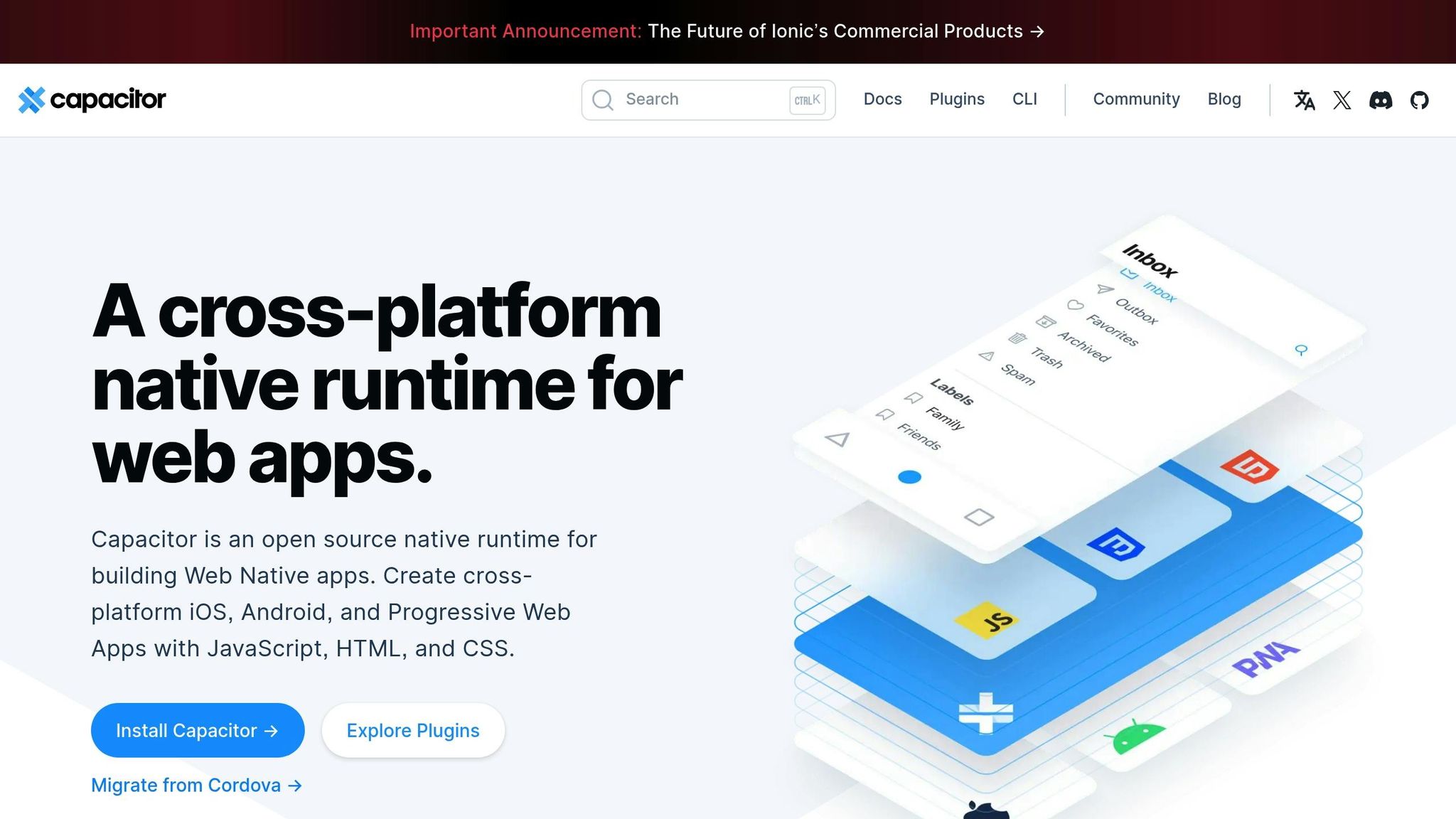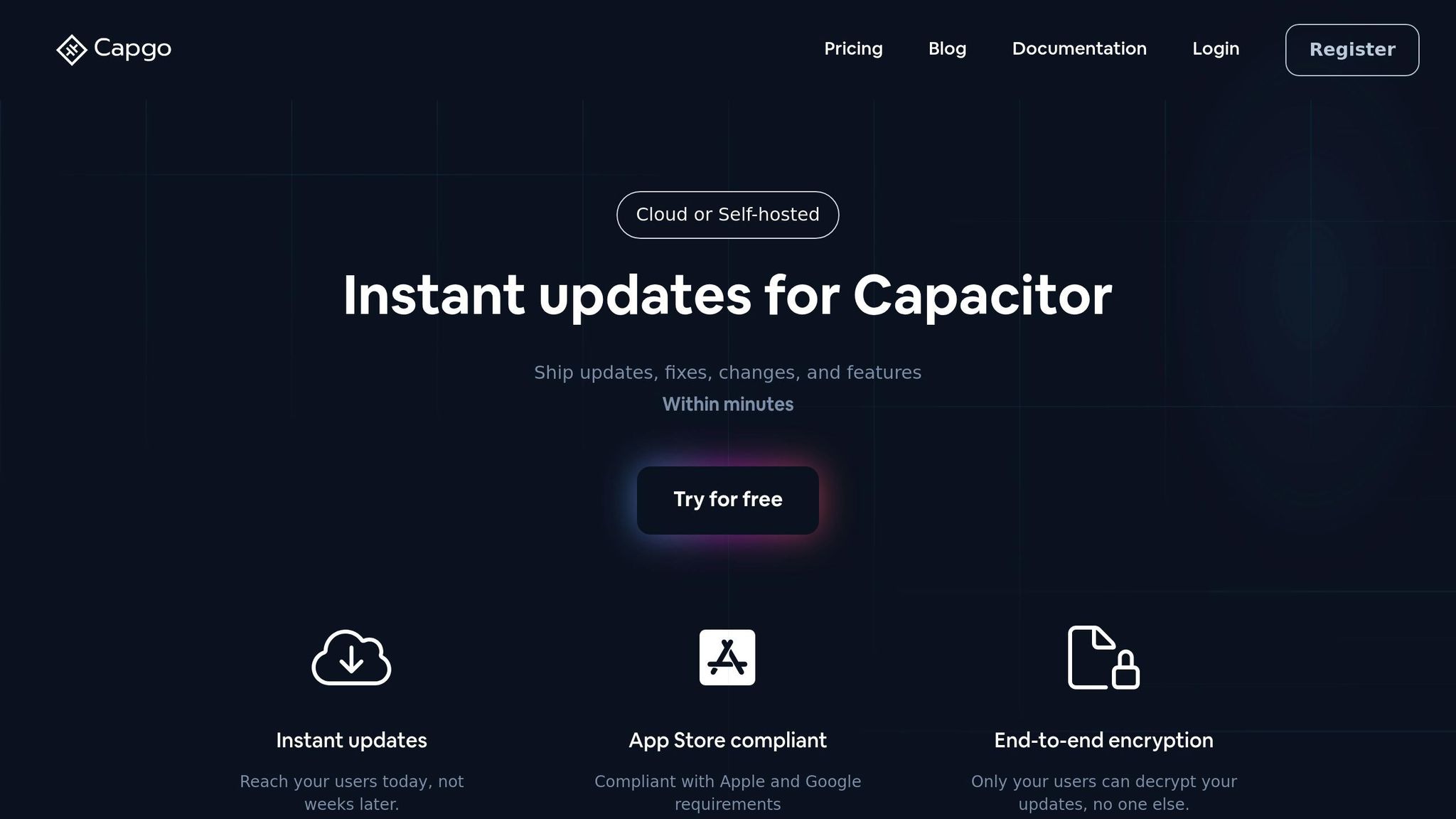Build failures in Capacitor CI/CD pipelines can disrupt mobile app development, costing time and money. Here’s a quick guide to common issues and how to fix them:
Key Problems and Solutions:
- Version Conflicts: Ensure Node.js, npm, Capacitor, and plugin versions match across environments.
- iOS/Android Setup Issues: Align Gradle, CocoaPods, Xcode, and SDK configurations.
- Environment Variables: Double-check API keys, credentials, and paths for consistency.
- Plugin Mismatches: Match Capacitor and plugin versions carefully.
- CI Platform Constraints: Optimize resources, caching, and platform-specific runners to prevent timeouts.
Quick Tips:
- Lock dependencies in
package.jsonto avoid unexpected updates. - Use tools like
npx cap doctorand Android Lint for debugging. - Replicate CI environments locally with
.envfiles for better testing. - Implement live updates to bypass app store delays.
Pro Tip: Tools like Capgo can simplify monitoring, secure configurations, and provide real-time rollback options when failures occur.
How to identify and fix CI pipeline problems
Main Types of Capacitor Build Failures

Capacitor build failures can arise from various sources, each requiring specific solutions. Below, we’ll break down some of the most common causes and how they manifest during the build process.
Version Conflicts Between Dependencies
Conflicting versions of Node.js, npm, and the Capacitor CLI are a frequent culprit behind build failures. These conflicts often occur due to mismatched expectations between different components of the build system. Here are some common scenarios:
- Differences in Node.js runtime versions between local machines and CI environments.
- Inconsistencies in package managers, like npm or Yarn.
- Mismatched versions of Capacitor core libraries and plugins.
- Platform-specific SDKs requiring specific versions that aren’t aligned.
Managing these dependencies becomes even trickier in multi-environment setups, where configurations can vary widely.
iOS and Android Setup Issues
Native platform configurations can be a major pain point, especially during initial setup or after significant updates. Problems often arise due to misaligned tools or outdated settings.
For Android, common issues include:
- Gradle sync errors after installing plugins.
- Using outdated SDKs or build tools.
- Incorrectly set
JAVA_HOMEenvironment variables. - Missing or corrupted Gradle wrapper files.
For iOS, frequent problems include:
- Dependency conflicts with CocoaPods.
- Inconsistencies in Xcode build artifacts.
- Misconfigured code signing certificates.
- Outdated build settings following Capacitor updates.
These issues often require careful debugging and alignment of tools to ensure a smooth build process.
Environment Variable Setup Problems
Environment variables play a critical role in the build process, and even small misconfigurations can lead to recurring failures. These problems often surface when moving between development and CI environments. Common areas affected include:
- API keys for external services.
- Credentials for code signing.
- Platform-specific configuration values.
- Build environment paths and settings.
Ensuring consistent environment variable management across all environments is key to avoiding these pitfalls.
Plugin Version Mismatches
Plugins can introduce compatibility challenges that are tough to diagnose. A typical example involves balancing versions of Capacitor, Ionic, and specific plugins. For instance, resolving “Something Went Wrong” errors may require aligning Capacitor 3.5.1, Ionic 5, and CapacitorGoogleAuth 3.1.4, while ensuring the correct client ID is set in both capacitor.config.ts and strings.xml.
These mismatches often require meticulous attention to versioning and configuration details to resolve.
CI Platform Constraints
Continuous Integration (CI) platforms can introduce their own set of challenges, particularly when dealing with complex builds. Here’s a breakdown of common constraints and their impact:
| Constraint Type | Common Issues | Impact |
|---|---|---|
| Timeouts | Builds timing out on large apps | Incomplete builds |
| Resource Allocation | Limited memory during compilation | Failed builds |
| Platform Support | Limited iOS build support on Linux runners | Platform-specific failures |
| Caching | Inefficient dependency caching | Slower builds, timeout risks |
To mitigate these issues, teams should fine-tune their CI/CD pipelines by configuring proper timeout settings, allocating sufficient resources, and optimizing dependency caching. When building for iOS or Android, using platform-specific runners can also help maintain compatibility and improve performance.
Build Failure Debugging Steps
Debugging build failures effectively is crucial for keeping your CI/CD pipeline running smoothly. Let’s break down some practical steps to troubleshoot and resolve these issues.
Testing Build Failures Locally
Start by cleaning your local environment to eliminate cached files and dependencies that might cause conflicts. Use the following commands:
rm -rf node_modulesrm -rf platformsnpm cache clean --forcenpm installFor Android-specific builds, these commands can help resolve issues like missing scripts or assets:
npx cap update androidnpx cap copyNext, replicate your CI environment locally by creating a .env file. Include variables such as:
- API keys
- Build configuration flags
- Platform-specific settings
This ensures your local setup matches the CI environment as closely as possible.
Using Build Analysis Tools
Leverage build analysis tools to gain insights into potential problems. Here are a few tools and their key diagnostics:
| Tool | Purpose | Key Diagnostics |
|---|---|---|
| npx cap doctor | Environment health check | Dependency versions, platform setup |
| Android Lint | Static code analysis | Resource usage, compatibility issues |
| Xcode Analyzer | iOS build inspection | Memory leaks, API misuse |
While running builds, monitor stack traces, version conflicts, configuration files, and network access. These diagnostics can help pinpoint the source of failures and guide you toward a fix.
Matching Development Environments
Once you’ve identified the issues, align your local environment with your CI setup to avoid future problems. Here’s how:
Version Control
Lock down Node.js and dependency versions by avoiding range specifiers. Use package-lock.json to maintain consistency.
Platform Configuration
Ensure platform-specific settings are standardized. For example:
{ "webDir": "dist", "platformVersion": { "ios": "14.0", "android": "29" }}Build Scripts
Standardize your build and test scripts for consistent error handling and logging:
{ "scripts": { "build:ci": "npm run clean && npm run build && npx cap sync", "test:ci": "npm run test -- --ci --coverage" }}Build Failure Prevention Methods
Locking dependency versions is crucial to maintaining stable builds in your Capacitor CI/CD pipeline. Here’s a step-by-step guide to implementing strategies that help prevent build failures and improve reliability.
Dependency Version Control
To avoid unexpected changes that can disrupt your builds, lock dependency versions in your configuration files and retain lock files. Here’s an example of a package.json setup:
{ "dependencies": { "@capacitor/core": "5.0.0", "@capacitor/ios": "5.0.0", "@capacitor/android": "5.0.0" }, "engines": { "node": ">=16.0.0", "npm": ">=8.0.0" }}Key steps for managing dependencies effectively:
- Commit both
package.jsonandpackage-lock.jsonto your version control system. - Use private artifact repositories to securely store dependencies.
- Automate dependency scanning with tools like Dependabot.
- Set up alerts for critical security updates to address vulnerabilities promptly.
By locking dependencies, you reduce the risk of unexpected changes and can shift your focus toward optimizing your CI/CD pipeline.
Pipeline Performance Optimization
A well-optimized pipeline ensures faster and more efficient builds. Here are some methods to enhance performance:
| Area | Method | Outcome |
|---|---|---|
| Job Parallelization | Split testing into concurrent jobs | Faster build times |
| Caching Strategy | Use layer-based Docker caching | Reduced build duration |
| Resource Allocation | Assign properly sized runners | Improved efficiency |
For example, you can configure caching and retry logic in your CI/CD pipeline as follows:
cache: key: ${CI_COMMIT_REF_SLUG} paths: - node_modules/ - platforms/ - plugins/
interruptible: trueretry: max: 2 when: runner_system_failure“Containerizing the workflow, minimizing dependencies, and monitoring workflow velocity with alerts on performance drops can lead to more stable and faster builds.” – Darrin Eden [2]
Platform Compatibility Testing
Once dependencies are locked and the pipeline is optimized, it’s time to test your app across platforms to identify compatibility issues early. Below is an outline of testing levels and tools:
| Testing Level | Tools | Focus Areas |
|---|---|---|
| Unit | Jest, Mocha | Business logic and utilities |
| Integration | Cypress | Cross-platform functionality |
| End-to-End | Appium | Native features |
| Performance | Lighthouse | Resource optimization |
Additional tips for thorough testing:
- Enable crash reporting for both web and native layers.
- Use source maps to trace errors accurately during debugging.
- Leverage platform-specific developer tools to identify and resolve issues.
- Set up automated performance benchmarks to track improvements over time.
For iOS builds, confirm Xcode compatibility and signing configurations. For Android, ensure Gradle settings and SDK versions align with your target requirements. These steps will help you catch issues early and maintain consistent performance across platforms.
Using Capgo to Manage Build Failures

Capgo provides a suite of tools designed to help teams handle build failures in Capacitor CI/CD pipelines. By combining monitoring, secure configurations, and in-depth analysis, it supports teams in identifying, addressing, and preventing build issues. Below, we’ll explore how Capgo simplifies these processes to improve CI/CD efficiency.
Build Monitoring and Recovery
Capgo’s real-time monitoring keeps an eye on build statuses and deployment progress, offering insights through a detailed analytics dashboard. Here are some key metrics tracked by the platform:
| Metric Name | Benchmark |
|---|---|
| Update Delivery | 23.5M updates delivered |
| Success Rate | 95% of users updated within 24 hours |
| API Response Time | 434ms worldwide average |
| Bundle Download | 114ms for a 5MB bundle |
When issues arise, Capgo’s rollback system ensures quick recovery with features like:
- Automatic version tracking to monitor updates seamlessly.
- Real-time update monitoring for immediate issue detection.
- Precise deployment control to manage updates in phases.
- Error logging to pinpoint problems quickly.
Secure Configuration Management
Capgo doesn’t just monitor builds - it also protects critical configurations with robust security measures. Using end-to-end encryption, it minimizes the risk of configuration-related failures. For example, here’s a sample Capgo configuration:
# Example Capgo configurationsecure_config: encryption: end-to-end access_control: - role_based_access - multi_factor_auth variable_management: - encrypted_storage - version_controlThe platform also separates configurations for development, staging, and production environments, ensuring each environment operates independently and securely.
Build Failure Analysis Tools
Capgo’s analysis tools provide comprehensive insights into build failures, making it easier for teams to diagnose and resolve issues. These tools include:
- Detailed build logs with contextual information.
- Performance metrics tracking to monitor system health.
- Dependency conflict detection to flag compatibility issues.
- Environment configuration comparison to identify discrepancies.
For teams switching from other platforms, Capgo simplifies the transition with migration tools that include compatibility checks and configuration validation, ensuring a smooth setup and stable builds.
Conclusion: Creating Stable Capacitor Pipelines
Building stable Capacitor pipelines requires careful attention to managing dependencies, maintaining consistent environments, and keeping an eye on performance. At the heart of this process are version control systems and automated updates, which ensure the pipeline remains both secure and dependable. These practices highlight the importance of staying proactive when handling dependencies.
“Dependency management involves handling the external libraries, tools, and components an application relies on, ensuring they are correctly resolved, updated, and maintained throughout the development lifecycle.” - Jose Luis Amoros from Krasamo [1]
Modern CI/CD tools like Capgo simplify deployment and monitoring, making it easier to maintain pipeline stability. Below are some key strategies teams can adopt to strengthen their pipelines:
| Strategy | How to Implement | Why It Matters |
|---|---|---|
| Version Control | Pin dependencies to specific versions | Prevents unexpected compatibility issues |
| Environment Parity | Use containerization (e.g., Docker) | Ensures builds remain consistent across stages |
| Automated Updates | Use dependency scanners | Keeps security and performance up to date |
| Config Management | Separate environment configurations | Reduces deployment conflicts |
As Capacitor development continues to advance, following these strategies will empower teams to create pipelines that are both resilient and efficient. By focusing on these best practices, developers can mitigate risks and ensure smoother deployments.
FAQs
::: faq
How can I keep my Capacitor CI/CD pipeline stable across different environments?
To keep your Capacitor CI/CD pipeline running smoothly across different environments, consider these practical tips:
- Organize branches effectively: Implement a structured branch management strategy and require mandatory code reviews. This helps prevent conflicts and ensures your web and native code work well together.
- Automate builds and check variables: Automating your build processes and validating environment variables can significantly cut down on deployment errors.
- Test extensively: Conduct thorough testing across all environments, including unit and integration tests, to identify and resolve issues early.
Using tools like Capgo can make these processes easier. Capgo supports seamless CI/CD integration, offers instant updates, and provides quick rollback options when necessary. This helps ensure smoother deployments and reliable performance across all environments. :::
::: faq
How can I manage dependencies effectively to avoid build failures in Capacitor projects?
To keep your Capacitor projects running smoothly and avoid build failures, managing dependencies effectively is key. Regularly update your dependencies to patch security issues and stay compatible with the latest features. Tools like the Capacitor CLI, npm, or yarn can make this process easier and more efficient.
For platform-specific needs, rely on tools like CocoaPods for iOS and Gradle for Android to ensure proper handling of dependencies across platforms. To take it a step further, consider integrating automation through CI/CD pipelines. This can help catch issues early by running automated checks for dependency integrity and compatibility, reducing the chances of errors slipping through.
Adopting these practices will help ensure your Capacitor apps are built on a stable foundation with fewer development hiccups. :::
::: faq
How can Capgo assist with resolving build failures in Capacitor CI/CD pipelines?
Capgo takes the hassle out of diagnosing and fixing build failures in Capacitor CI/CD pipelines. It offers tools like automated error tracking, dependency conflict resolution, and environment variable validation to catch issues early and minimize build errors.
On top of that, Capgo simplifies over-the-air (OTA) updates with features such as rollback options, staged rollouts, and real-time monitoring. These tools make deployments smoother and more controlled. Plus, its integration with your existing CI/CD tools enables automated compliance checks and performance tracking, boosting the reliability and efficiency of your pipeline. :::




